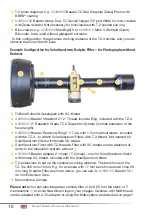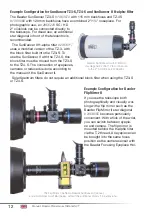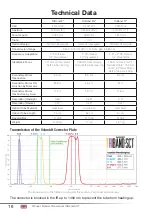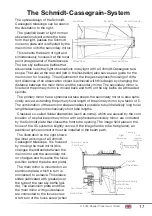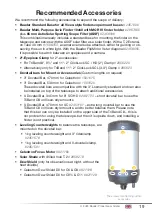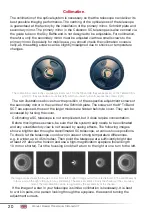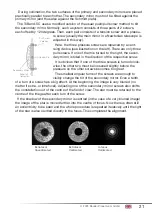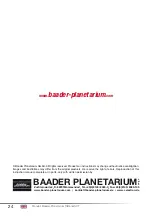
© 2023 Baader Planetarium GmbH
23
Cleaning Eyepieces
For eyepieces, the "Optical Wonder Fluid" has also proven to be very effective. Put
some fluid on a cloth and rub it over the front lens of the eyepiece. The inner lens
element should not be cleaned with fluid. You should only blow it out with a little com-
pressed air if dust particles become annoyingly noticeable when looking through the
eyepiece.
Please note
So that you have to clean as little as possible, please note these last important tips:
1. Avoid fingerprints on all optical surfaces at all costs. Fingerprints leave traces of
sweat and grease which attack the optical coatings and destroy them over time.
2. Avoid cleaning optical surfaces as much as possible.
3. If cleaning is necessary, use a special soft cloth (spectacle cleaning cloth).
4. Before cleaning, however, always remove dust from the surface to be cleaned with
a grease-free brush. Avoid dusting in general
5. Avoid hard knocks or blows to the telescope or mount. Do not try to adjust or turn
anything by force. All mechanical and/or electrical movements must be easy to
perform.
6. It goes without saying that you should not leave your telescope system out in the
rain. Furthermore, avoid – as far as possible – other harmful environmental influen-
ces such as car exhaust fumes etc.
7. Avoid dusty locations. During longer observation breaks, cover the telescope
and the mount with a plastic sheet (e.g. a large bin liner). Make sure that there is
sufficient ventilation to prevent condensation from accumulating. Always cover the
objective or light entrance opening and the focuser with the caps provided. Paying
attention to cleanliness will save you frequent cleaning.
Dew
In special seasons (spring, autumn) or at unfavourable observation locations (low loca-
tions between mountains or close to smaller bodies of water), it can happen that your
telescope becomes damp or downright wet in the course of the observation night due
to dew condensation.
Likewise, this can happen if you bring the night-cool instrument inside your home.
Then place the tube horizontally and cover the telescope with the protective covers
only when the moisture has dried off.


